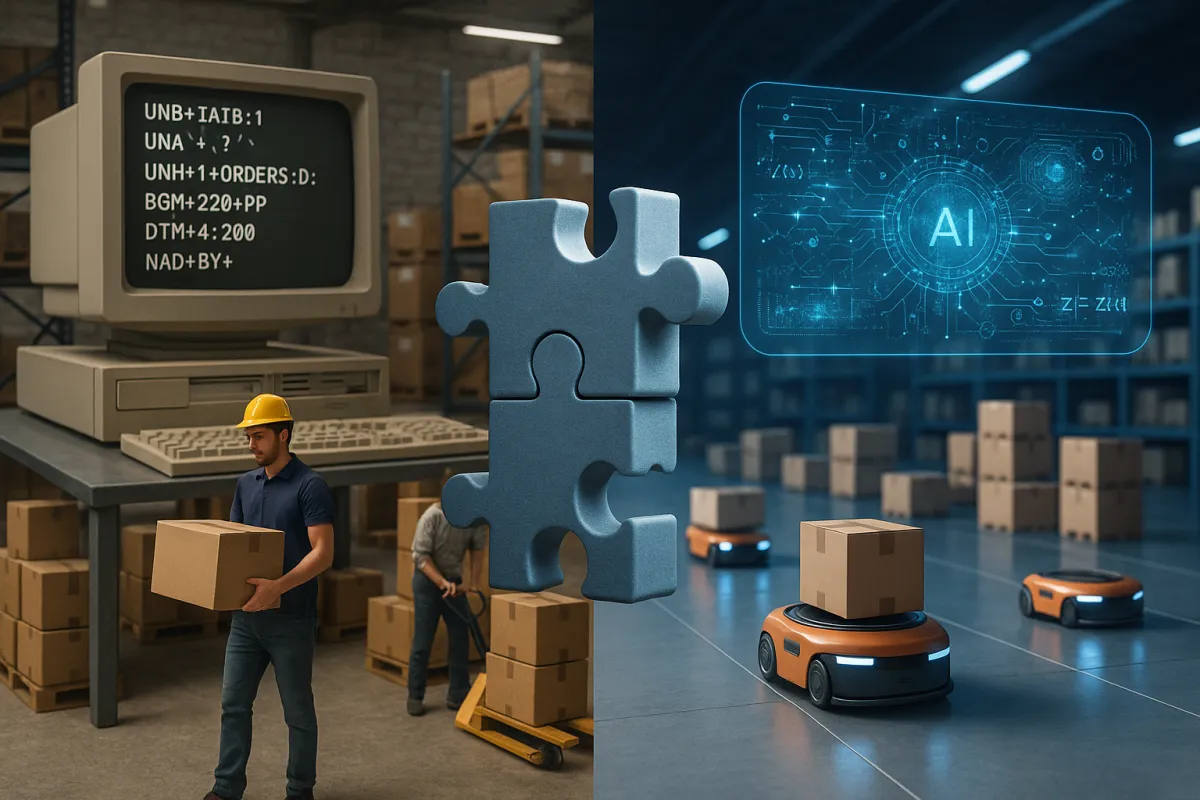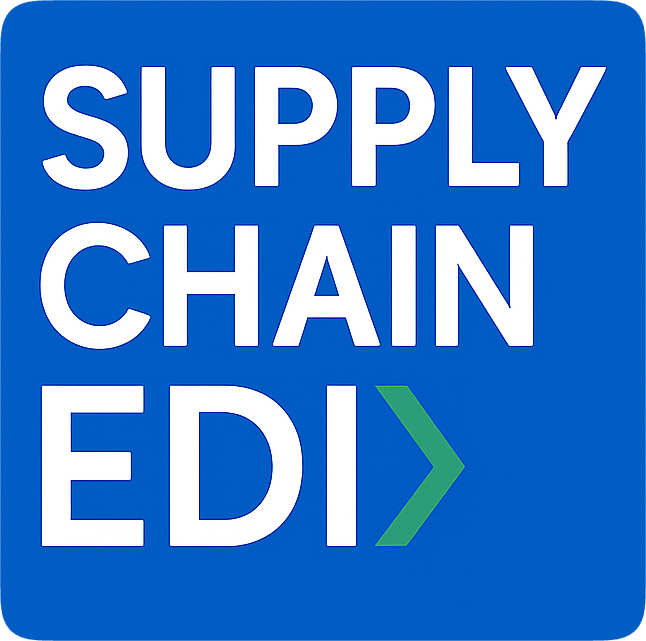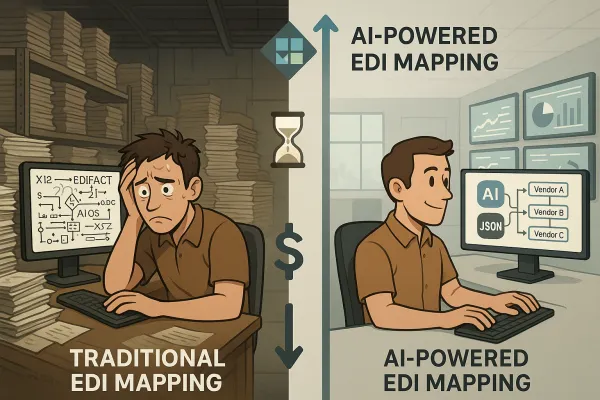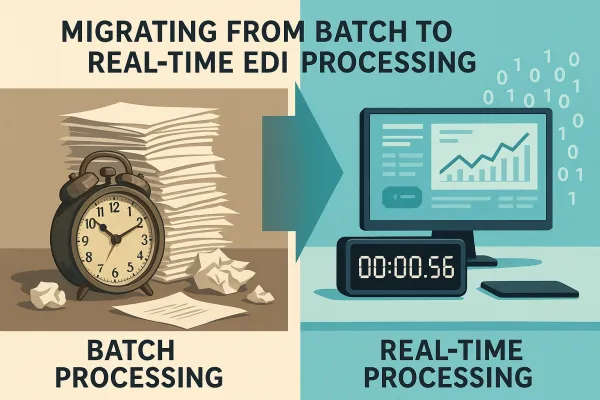The Hidden Costs of AI-Powered EDI Integration: 7 Implementation Challenges (And How to Budget for Success)

Most companies discover that integrating AI into existing EDI systems requires significant investment in technology, infrastructure, and expertise. Smaller businesses may find it challenging to afford the upfront costs of AI adoption. Yet vendors keep pitching AI-EDI integration as a simple plug-and-play solution. The reality? Your implementation costs often exceed initial estimates by 30-50%, particularly when you factor in the hidden complexities of modernizing legacy systems.
Take the manufacturing sector, where data mapping has traditionally been the most time-consuming and expensive aspect of setting up EDI connections. While AI can speed up the mapping process and improve the business case for EDI connectivity, you're still dealing with semantic data models that vary wildly between organizations. Your EDIFACT purchase orders from Supplier A won't magically align with Supplier B's X12 format just because you've added AI to the mix.
Companies often underestimate these implementation challenges because they focus on the technology rather than the organizational change required. Studies indicate that companies investing in AI are realizing significant returns, with an average ROI of $3.7 for every $1 invested. Notably, 5% of organizations worldwide are achieving an even higher average ROI of $10 for every $1 invested. However, AI projects often have long-term benefits that may not be fully realized in the short term. As per a recent IDC Study in Nov 2024, organizations realize value in 14 months.
The competitive landscape shows different approaches to this challenge. IBM Sterling and Cleo push comprehensive platform overhauls, while SPS Commerce focuses on gradual AI enhancement of existing workflows. TrueCommerce takes a hybrid approach, offering both immediate AI fixes and longer-term transformation paths. Meanwhile, solutions like Cargoson emphasize API-first architectures that make AI integration more manageable from the start.
Challenge #1: Legacy System Compatibility and Technical Debt
Your biggest headache isn't the AI itself - it's getting it to work with EDI systems built 20 years ago. The outdated formats, rigid workflows, and lack of API support typical of legacy EDI systems highlights that they weren't designed with AI in mind, making integration challenging. These systems were built for predictable, structured data flows, not the dynamic pattern recognition that AI excels at.
Consider a typical automotive supplier running EDIFACT standards through a VAN connection. Your existing system handles ORDERS, DESADV, and INVOIC messages perfectly - as long as the data follows exact specifications. But AI thrives on flexibility and learning from variations in data patterns. This fundamental mismatch creates integration nightmares that vendor demos conveniently skip.
The technical debt compounds when you realize that the key challenges in using AI for EDI data mapping relate to the underlying complexity of EDI in general and to the semantic data models used by different organizations. Your "CustomerID" field might map to "BuyerCode" in one partner's system and "ClientRef" in another's. AI can learn these patterns, but first you need clean, consistent historical data - which most legacy EDI systems don't provide.
Solutions like MercuryGate and Descartes TrueCommerce tackle this by creating middleware layers that abstract the complexity. Cargoson's approach focuses on API-first integration that bypasses many legacy system limitations entirely. Solutions such as Boomi provide ready-made integrations and standard industry connectors, simplifying the mapping and transformation of EDI documents, automating workflows, and guaranteeing smooth communication.
Data Quality Prerequisites Most Companies Overlook
AI models need high-quality, consistent data to function properly. AI models require high-quality data to function effectively. Inconsistent or incomplete datasets can lead to incorrect predictions and automation errors, potentially causing disruptions in business processes. Most EDI systems accumulate years of inconsistent data formats, partial transactions, and error corrections that create training challenges for AI algorithms.
Here's what typically happens: Your legacy system contains 500,000 historical transactions, but 30% have incomplete address data, 15% contain manual overrides that bypass standard formatting, and another 20% represent exception handling that never got properly documented. Feed this to an AI system, and you'll get unpredictable results.
Real-world example: A major retailer spent six months trying to train an AI system to predict delivery delays using historical EDI shipment data. The system kept flagging normal deliveries as problematic because the training data included thousands of records where "estimated delivery date" was manually adjusted without updating the corresponding shipment status codes. They had to clean and normalize three years of data before the AI could produce reliable predictions.
Challenge #2: The True Cost of AI Training and Customization
Market studies show that AI development costs $50k - $500k+ depending on the complexity and scope of the project. For EDI-specific implementations, you're typically looking at the higher end of this range because you're dealing with industry-specific standards, multiple partner requirements, and complex data transformation needs.
Break down the real costs beyond the initial software licensing. You need specialized talent who understand both AI/ML concepts and EDI protocols - a rare combination that commands premium rates. Training data preparation alone can consume 40-60% of your initial project budget. AI adoption requires some investment in infrastructure upgrades. However, those costs can vary substantially depending on your approach. Adopting scalable cloud-based models allows you to start small and expand as needed.
Consider the ongoing maintenance burden. Your AI model needs continuous retraining as EDI standards evolve, partner requirements change, and data volumes grow. This isn't a set-it-and-forget-it solution. Plan for 20-30% of your initial development cost annually just for model maintenance and updates.
Different vendors structure these costs differently. Orderful and Boomi typically bundle AI features into their platform subscriptions, while nShift offers modular AI components with separate pricing. Traditional solutions often require significant customization work, pushing total costs higher than anticipated. The key is understanding not just the licensing fees, but the total cost of ownership including training, customization, and ongoing support.
Challenge #3: Security and Compliance Complexity with AI Systems
AI systems rely on vast amounts of data for training and optimization. This raises concerns about data privacy, compliance with regulations such as GDPR, and the risk of cyber threats targeting AI-enhanced EDI platforms. Your AI system needs access to transaction histories, partner data, and often personally identifiable information embedded within business documents.
GDPR compliance becomes particularly thorny when your AI system learns patterns from historical data that includes EU customer information. You can't simply anonymize EDI transaction data because the business logic often depends on specific partner relationships, geographic patterns, and temporal sequences that anonymization would destroy.
Industry-specific regulations add another layer of complexity. Healthcare EDI must comply with HIPAA requirements, financial services face SOX and PCI DSS obligations, and automotive suppliers must meet strict traceability standards. AI-driven EDI systems must comply with industry regulations and standards. Ensuring compliance while implementing AI-based automation can be challenging, particularly in highly regulated industries such as healthcare and finance.
Alpega and FreightPOP address these concerns through specialized compliance frameworks built into their AI modules. Cargoson focuses on data minimization approaches that limit AI access to only essential transaction elements, reducing compliance risk. The challenge is balancing AI effectiveness with regulatory requirements - more data typically means better AI performance, but also greater compliance complexity.
Challenge #4: Staff Training and Change Management Resistance
Many organizations, particularly those with legacy EDI systems, may resist adopting AI due to concerns about complexity, job displacement, or potential disruptions to established workflows. Your EDI team has spent years mastering complex mapping rules, partner-specific requirements, and exception handling procedures. Introducing AI feels like questioning their expertise.
The resistance isn't just emotional - it's practical. Employees unfamiliar with EDI AI may be concerned about new processes and wonder how they will transition to the new system. To counteract this, businesses may need structured training programs to educate teams about AI-driven workflows. Your staff needs to understand not just how to use AI tools, but when to trust AI recommendations versus when to override them.
Budget for substantial training investments. Plan 3-6 months for basic AI literacy training, another 3-6 months for system-specific training, and ongoing education as AI capabilities evolve. This isn't just technical training - your team needs to learn new ways of thinking about problem-solving and decision-making in AI-augmented environments.
TMS providers like Transporeon and Blue Yonder have developed comprehensive training programs that combine technical skills with change management support. Cargoson's approach emphasizes gradual capability introduction, allowing teams to build confidence with simpler AI features before tackling complex automation scenarios.
Building Internal AI-EDI Expertise vs. Outsourcing
The build-versus-buy decision becomes more complex with AI integration. Outsourcing AI development is typically more cost-effective, especially for companies that lack the necessary in-house AI expertise. However, EDI requires deep domain knowledge that generic AI consultants often lack.
Building internal expertise costs more upfront but provides better long-term control. Expect to pay $120,000-$180,000 annually for experienced AI-EDI specialists, and you'll need at least 2-3 people to handle development, operations, and business analysis. Training existing EDI staff in AI concepts typically takes 12-18 months to reach productivity levels.
Outsourcing offers faster implementation but creates dependency risks. Your outsourcing partner needs to understand both AI techniques and EDI business processes. This specialized knowledge commands premium rates - expect 30-50% higher costs than standard AI consulting rates.
Challenge #5: Integration Complexity and Workflow Disruption
Rushing AI-EDI implementation typically leads to workflow disruptions that can damage partner relationships and disrupt business operations. One of the biggest challenges in EDI is handling exceptions, such as missing data, incorrect formats, or compliance issues. AI can automatically resolve common discrepancies by learning from past patterns, minimizing human intervention and speeding up transaction processing, but only if implemented carefully with proper fallback procedures.
The integration challenge multiplies when you consider that EDI systems rarely operate in isolation. Your AI enhancement needs to work with ERP systems, warehouse management systems, transportation management systems, and various partner portals. Each integration point represents potential failure modes that need careful planning and testing.
Manhattan Associates' Active platform and Oracle TM approach this through extensive pre-built connectors and standardized APIs. SAP Transportation Management offers AI modules designed specifically for their ecosystem. In contrast, Cargoson takes a more flexible approach, building AI capabilities that can adapt to various existing system architectures without requiring major infrastructure changes.
Successful implementations typically follow a phased approach: start with read-only AI analysis of existing data flows, then gradually introduce AI-driven recommendations, and finally move to automated decision-making for low-risk scenarios. This progression allows your team to build confidence and refine the system before committing to full automation.
Calculating Real ROI: Beyond the Marketing Promises
Vendor marketing materials promise dramatic ROI improvements, but calculating realistic returns requires understanding both the benefits and the total cost of ownership. The principle of ROI is simple. On the other hand, this simplicity is also dangerous because you can decide the parameters when calculating the cost or profit. Cost side is typically simpler but on the profit side one should stick to easily measureable factors.
Start with measurable efficiency gains. Minimizing manual work by automating the trade with EDI. This is direct saving on the labor costs (FTE). E.g. orders processing is at least five times faster when using EDI. AI can potentially accelerate this further, but be conservative in your estimates. A 20-30% improvement in processing efficiency is realistic; claims of 80% improvement usually ignore hidden complexity and exception handling requirements.
Factor in revenue impact carefully. Faster order processing might reduce customer wait times, and better inventory accuracy might prevent stockouts. However, these benefits take time to materialize and depend on factors beyond just AI implementation. To calculate AI ROI, use this formula: (Benefits – Costs) / Costs × 100. However, measuring AI ROI requires a comprehensive framework that goes beyond simple cost savings. The most effective approach uses four key areas: efficiency gains, revenue generation, risk mitigation, and business agility.
Use realistic timeframes for ROI calculations. In Forrester's Q2 AI Pulse Survey, 2024, 49% of U.S. gen AI decision-makers said their organization expects ROI on AI investments within one to three years, and 44% said within three to five years. For EDI-AI integration, lean toward the longer timeframes - the complexity of B2B integration means benefits often take 18-24 months to fully materialize.
When to Start Small vs. Full Implementation
Start Small: Begin with a proof-of-concept study, then try launching a pilot AI-driven application before deploying a full-scale solution. This approach makes particular sense for EDI-AI integration because the complexity of partner relationships and business processes makes full-scale implementations risky.
Consider starting with internal process optimization before touching partner-facing workflows. Use AI to analyze your own EDI transaction patterns, identify bottlenecks, and optimize internal routing rules. This builds confidence and provides measurable benefits without risking partner relationships.
Scalable cloud-based models offer flexibility for gradual expansion. You can start with a single partner or product line, validate the approach, and then expand systematically. This reduces upfront investment risk and allows you to refine your approach based on real-world results rather than theoretical projections.
Success in AI-EDI integration comes from understanding that this isn't just a technology upgrade - it's a fundamental change in how your organization processes and learns from B2B transaction data. The companies achieving genuine ROI are those that invest in both the technology and the organizational capabilities needed to use it effectively. Align AI to C-level strategy: AI transformation must be driven from the top, with clear governance structures and strategic alignment. Organizations achieving the highest ROI treat AI as a core business capability, not an IT initiative.
Your next step should be conducting a realistic cost-benefit analysis based on your specific EDI environment, partner requirements, and organizational capabilities. Factor in not just the technology costs, but the training, change management, and ongoing maintenance requirements that determine whether your AI-EDI integration delivers actual business value or becomes another expensive technology experiment.





